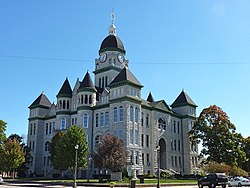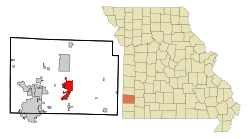Carthage, Missouri
Carthage, Missouri | |
|---|---|
 Jasper County Courthouse on the historic Carthage Square | |
 Location of Carthage, Missouri | |
| Country | United States |
| State | Missouri |
| County | Jasper |
| Area | |
| • Total | 9.6 sq mi (24.8 km2) |
| • Land | 9.5 sq mi (24.7 km2) |
| • Water | 0.0 sq mi (0.1 km2) |
| Elevation | 1,004 ft (306 m) |
| Population (2000) | |
| • Total | 12,668 |
| • Density | 1,328.2/sq mi (512.8/km2) |
| Time zone | UTC-6 (Central (CST)) |
| • Summer (DST) | UTC-5 (CDT) |
| ZIP code | 64836 |
| Area code | 417 |
| FIPS code | 29-11656Template:GR |
| GNIS feature ID | 0715455Template:GR |
Carthage is a city in Jasper County, Missouri, United States. The population was 12,668 at the 2000 census. It is the county seat of Jasper CountyTemplate:GR and is nicknamed "America's Maple Leaf City."[1]
History
Jasper County was formed in 1841. Carthage was chosen as the county seat, the area cleared and the town platted in 1842. By the time of the American Civil War, there were over 1000 residents, a brick and stone courthouse and several businesses.
The area was divided over slavery, and almost all of the African-Americans in the county at the time were slaves. The Battle of Carthage, fought on July 5, 1861, was a clash between Union troops from St. Louis and Confederate troops led by the pro-Southern Missouri Governor, Claiborne Fox Jackson. The "Second Battle of Carthage" occurred in October 1863 when Union troops confronted Confederate troops north of town and forced them to return to Arkansas. The town experienced minor skirmishes and attacks throughout the war; pro-Confederate guerrillas burned most of the city (including the courthouse) in September 1864.
The area grew rapidly following the Civil War. The Missouri Western Railroad arrived in 1872. Town residents started a foundry, furniture factory, woolen and grain mills, a plow works and numerous liveries and other businesses.[1] Leggett & Platt, now a Fortune 500 company still based in Carthage, was founded in 1883. Nearby lead mines and a limestone quarries also contributed significant wealth and Carthage became one of the most prosperous towns in the area. Residents poured their money into ornate Victorian-style homes, many of which are now part of the Carthage South District, which was named to the National Register of Historic Places in 1982. The Jasper County Courthouse, also on the National Register of Historic Places, was built of Carthage stone in 1894-95. There is a mural insided the courthouse depicting the history of Jasper County.
Numerous local buildings, in addition to the courthouse, were built in the late 19th and early 20th century out of stone from local quarries. The stone is hard enough to be polished into "Carthage marble" and was used in both the interior and exterior of the state capitol building in Jefferson City, Missouri.
In 1925, Ozark Wesleyan College merged three Methodist colleges into one institution and built a campus in the center of town. The college operated only a few years before closing. The campus was home to Our Lady of the Ozarks College from 1944-1971 and now houses the Vietnamese-American Catholic religious Congregation of the Mother Co-Redemptrix. This Vietnamese order of priests and brothers came from Vietnam to settle in Carthage in 1975, immediately following the Vietnam War.[2] In the monastery of this Vietnamese congregation the controversial archbishop Pierre Martin Ngô Đình Thục died in 1984.
U.S. Highways 66 and 71 came through town in the 1920s, and for a time the town saw a stream of cross-country traffic. Route 66 was eventually re-routed, and then replaced in the 1960s with Interstate 44 running south of town.
In the late 20th century, the town began actively courting tourism, emphasizing its history (the Battle of Carthage, Victorian architecture, and Route 66), as well as its proximity to the Precious Moments hotel and store, along with the popular country music destination Branson, Missouri.
Geography
Carthage is located at 37°10′4″N 94°18′54″W / 37.16778°N 94.31500°WInvalid arguments have been passed to the {{#coordinates:}} function (37.167773, -94.314958)Template:GR. According to the United States Census Bureau, the city has a total area of 9.6 square miles (24.8 km²), of which, 9.5 square miles (24.7 km²) of it is land and 0.04 square miles (0.1 km²) of it (0.42%) is water.
Demographics
As of the censusTemplate:GR of 2002, there were 13,316 people, 4,813 households, and 3,157 families residing in the city. The population density was 1,328.2 people per square mile (512.7/km²). There were 5,217 housing units at an average density of 547.0/sq mi (211.1/km²). The racial makeup of the city was 86.71% White, 1.54% African American, 1.05% Native American, 1.59% Asian, 0.21% Pacific Islander, 6.65% from other races, and 2.25% from two or more races. Hispanic or Latino of any race were 12.54% of the population.
There were 4,813 households out of which 30.9% had children under the age of 18 living with them, 49.5% were married couples living together, 11.9% had a female householder with no husband present, and 34.4% were non-families. 30.0% of all households were made up of individuals and 16.4% had someone living alone who was 65 years of age or older. The average household size was 2.49 and the average family size was 3.04.
In the city the population was spread out with 25.4% under the age of 18, 10.9% from 18 to 24, 27.4% from 25 to 44, 18.6% from 45 to 64, and 17.6% who were 65 years of age or older. The median age was 35 years. For every 100 females there were 95.2 males. For every 100 females age 18 and over, there were 89.7 males.
The median income for a household in the city was $28,557, and the median income for a family was $33,927. Males had a median income of $26,315 versus $19,442 for females. The per capita income for the city was $15,281. About 12.7% of families and 19.2% of the population were below the poverty line, including 23.5% of those under age 18 and 13.0% of those age 65 or over.
Education
Carthage currently has one high school, one middle school, and five elementary schools, along with quite a few religious schools such as a Vietnamese school, the Victory Academy for Christians, and St. Anns' Catholic School, with many more. As of after Christmas 2008, Carthage High School will be moved near the Fair Acres Family YMCA due to rapidly growing class sizes. The new high school will be so large it will actually be able to fit all elementary(including religious elementary schools), and half of the Jr. High.[citation needed] The Jr. High may be moved to the old high school, or the new high school may become the high school for the other side of town.[citation needed] If the Jr. High is moved, the old one may remain a Jr. High or converted into the largest elementary school in Carthage.[citation needed]
Economy
Major area employers include Leggett & Platt, a Fortune 500[citation needed] corporation manufacturing household durables, which is headquartered in the town, Williams Lighting (a manufacturer of home electric lighting implements), Otts Foods, Schreiber Cheese, and Goodman Manufacturing (all producing various food products) and the Carthage Underground, formerly a quarry, which now serves as a storage area with climate control for various products. Carthage was well-known in the early 20th century for the fine-grained, extremely dense grey limestone, "Carthage Marble," which came from that mine and was used for numerous public buildings throughout the nation, including the Capitol Building in Jefferson City and the Jasper County Courthouse.
Carthage has several food manufacturers and processing plants in and around the city. These plants produce a great deal of slaughterhouse waste. Changing World Technologies and its subsidiary Renewable Environment Solutions built the first operational commercial thermal conversion plant in the United States to take advantage of the large amount of feedstock for the thermal conversion process made available by the many food rendering plants in the area in 2003.
While there were complaints throughout 2005 of foul odors coming from the plant, several steps claim to have been taken by the plant operators to eliminate these odors.[citation needed] As of October 2008, the odors are still very prominent in the north end of town.
In Jan 2008, a new city-owned hospital, McCune-Brooks, is scheduled to open and the old facility to be given to Missouri Southern State University, which will relocate some of its programs there from current space in nearby Joplin.[citation needed] A new high school is also being constructed, expected to be finished in 2008.
Culture
As noted above, Carthage was the site of the Battle of Carthage, the first official engagement of the American Civil War, on July 5, 1861. Local groups stage reenactments of the battle, near the grounds of the State Historic Site which commemorates the event.
Carthage is located on Historic U.S. Route 66. The original alignment around town is still marked, and several old businesses built to cater to travelers can still be seen. [3]
Since 1966, Carthage has held a festival each October called the Maple Leaf Festival.[4] The week-long festival is named for the many maple trees that grow in the town, whose leaves change into bright colors such as red, orange, and yellow in the fall. Many people from towns from all over Jasper County and further attend the parade, bringing applicants for the parade such as hometown bands, businesses, spookhouses, television stations, and various entertainment. It is a tradition for the people participating in the parade to hand out large amounts of candy to children, as well as advertisements and other small items such as frisbees and footballs. The parade usually runs from the town square, where snacks can be bought and ends at the junior high school, where children can be picked up.
Since 1978, Carthage has hosted the annual Marian Days celebration for Vietnamese American Catholics. The event, which typically draws 50,000 to 70,000 attendees, takes place on the 28 acre campus of the Congregation of the Mother Co-Redemptrix.[2]
Carthage is also the home of the Precious Moments Park and Chapel, a tourist attraction with paintings and oversized depictions of the popular porcelain figurines.[5]
Notable natives
- A. P. (Ace) Borger, businessman associated with Texas (1888-1934)
- Jann Carl, Entertainment Tonight correspondent (b. 1960)
- Frances Crowe, peace activist (b. 1919)
- Carl Hubbell, baseball player (1903-1988)
- Preston Lacy, part of the Jackass cast
- Marlin Perkins, naturalist and host of Mutual of Omaha's Wild Kingdom (1905-1986)
- Belle Starr (Myra MayBelle Shirley), Wild West outlaw (1848-1889)
- Bertha Teague, basketball coach, member of the Basketball Hall of Fame (1906-1991)
- Felix Wright, NFL Football Player (1985-1992)
References
- ^ Carthage, Missouri Chamber of Commerce - America's Maple Leaf City!
- ^ Because of this, it makes Carthage the third largest city in the state for a week or so.
"Vietnamese Americans Make Pilgrimage to Missouri". National Public Radio. August 5 2007. Retrieved 2007-08-05.
{{cite web}}: Check date values in:|date=(help)
External links
- Chamber of Commerce
- Carthage, Missouri Convention & Visitors Bureau
- Carthage, Missouri-The Most Beautiful City in the West (1906 promotional booklet) at Joplin Public Library
- Powers Museum - Carthage
- Carthage Press - Daily newspaper

